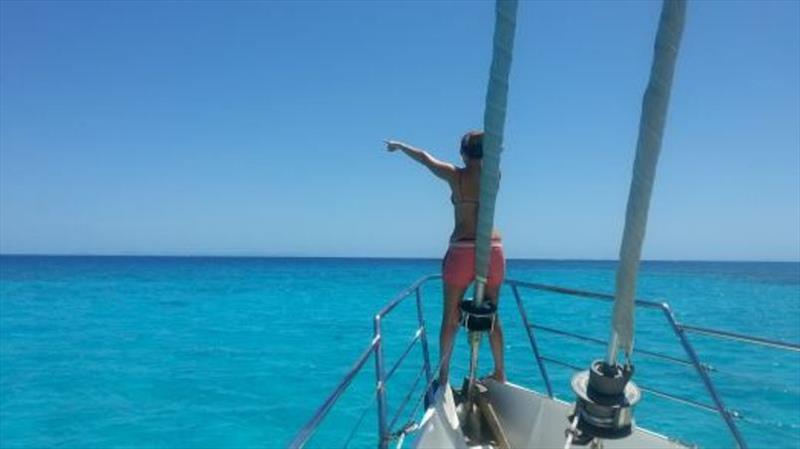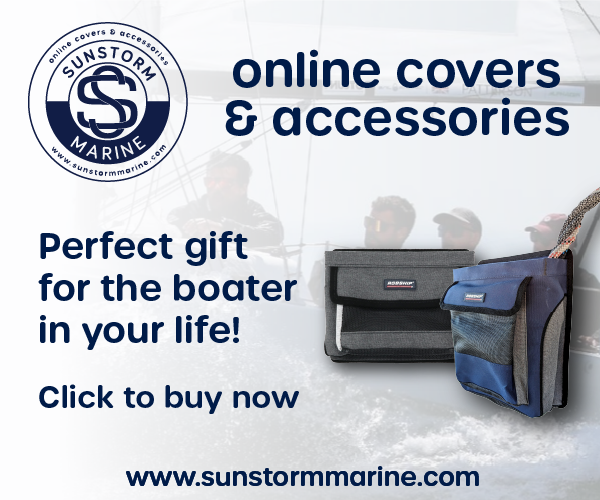
Navigating by watercolour
by Cindy Smith, Island Cruising 6 Feb 2018 08:08 UTC

Navigating by watercolour © Island Cruising
No, this is not about painting, but instead a very important job on a boat which finds itself in the South Pacific: the R.N, otherwise known as Reef Navigator. (In impolite circles, this job is called bow wench, but not on our boat!).
This job is necessary because:
1) electronic charts are notoriously wrong in this part of the world,
2) paper charts are not detailed enough,
3) one thing in Tonga is 100% true: there is NOT a 1:1 ratio of reef: island.
If there is an island, there ARE reefs. But conversely, there are reefs with no islands.....lurking below the surface with no warning arrow pointing down. Just like the stethoscope required by the other RN job of which I am intimately familiar, there is one VITAL piece of equipment necessary for the Reef Navigator in order to perform the job with supreme excellence: Polarized Sunglasses. These not need to be expensive, but they DO need to be maintained and a backup ensured. The maintenance of this priceless piece of equipment includes a leash/croakie, padded storage case (preferably floatable), and lots of good quality lens cleaner with an especially soft lens cloth. Advice to want-ta-be RN's: spend the money on lens cleaner!!
It is SO much better than soap and water. After obtaining the necessary equipment, the RN must learn to navigate the ever-present reefs by interpreting the colour of the water. THE most important thing is for the RN to impress upon M&C - Master and Commander that the boat needs to move west BEFORE noon and east AFTER noon. And NEVER move at night. Otherwise, RN will not be able to read the watercolour.
Here's how...
If the watercolour is:
Blue/black: You are in deep water and the depth sounder may or may not be coughing up data. So relax, make some lunch, or better yet rest your eyes because in the RN job, they work very hard. In the cockpit of course, since M&C may bark some inane order regarding sail trim. In that case, feign sleep. But if the order is "I need you on the bow NOW", it is best not to argue (too much) since this is, after all, your job.
Indigo blue: You are still in deep water, but the depth sounder will now be giving you a reading suchas 150 feet, so just keep on relaxing, but with one eye on the depth sounder and the other on M&C. Napping at this time is unprofessional, but reading a book is OK (especially the one with instructions on the next anchorage).
White flashes on the horizon: This phenomenon requires a high degree of diligence, and is the reason the RN deserves such a high salary. It is found with frequent glances to the horizon and requires serious evaluation, since the cause could be several things. First, hold your hand up to the horizon and measure the length of the white flash between your thumb and forefinger. If the length of the white flash is greater than or equal to one inch and is appearing then disappearing, it is a reef or "blind rollers". This finding is confirmed when the white flashes get closer in distance and are in a weird, constantly moving line. Upon confirmation, shout to M&C "breaking waves ahead" and make sure he changes course.
If the length of the white flash is less that 1 inch and shooting straight up in the air at long intervals, it is whales breaching. This has been known to happen 6-8 times before disappearing. Jump up, grab the binoculars and shout to M&C "whales 20 degrees off starboard bow!" This shows RN is willing to go above and beyond the call of duty and should get a raise.
If the white flashes are multiple and widely dispersed, check wind speed. If over 10 knots, you are seeing whitecaps and/or a current line. If less than 10 knots, you are probably seeing a current line. Say nothing, since M&C already knows this.
If the length of the white flash is less than 1/2 inch and constant, it is another boat. Ho hum -bearing/distance and all of that. Nonchalantly mention "boat off to port" to M&C who has probably already seen it on radar.
Brilliant turquoise: This colour is like a bright beacon glowing from below and could be the RN's best friend or not, depending on circum stances. If you are not approaching an anchorage, shout to M&C "reef ahead" and make sure he changes course. If you ARE approaching an anchorage, this is GOLD because it means SAND!! Direct M&C to this spot, drop the hook, and get ready to pour the sundowners.
Brilliant turquoise with black spots: Black spots (coral heads) are not good. If there is less than aboat-length-wide piece of brilliant turquoise (SAND!), don't get cocky. Avoid the temptation to dump the anchor between black spots because Murphy WILL guarantee the hook gets hopelessly tangled and M&C will be VERY cranky when he has to retrieve it with dive tank.
Turquoise/green: the water is getting shallow. In open ocean, you will already have seen brilliant turquoise and taken appropriate action. Approaching an anchorage and seeing this colour, assertively request M&C go to neutral gear, and if there is an argument, firmly state " Excuse ME! What can YOU see from back THERE!?"
Muddy brown/green: If you are in the big boat, scream at the top of your lungs "REVERSEREVERSE NOWWWWWWWWWWW!
If you are in the dinghy, proceed with caution.
Pale tan: dive for the dingy kill switch, then jump out and point the bow into the waves.
Mother nature has a sense of humour and always keeps the RN's job interesting........................
You are sailing along, relaxing on blue/black water and the depth gauge suddenly reads 20ft. There is no way this could be true, but the prudent M&C lunges for the controls and shifts to neutral.
After several LONG seconds, the depth sounder starts flashing "last reading" before the 20ft. M&C just shrugs and says mysteriously, "thermocline", but RN KNOWS the reason is that a whale was curiously swimming 20 ft. under the boat.
Of course clouds will come and go in the course of the day. Unfortunately, they throw a shadow on the water that makes the RN earn her salary. For example, a cloud can make blue/black look indigo, which is not a problem since both are deep water. What REALLY frustrates the RN is in the process of anchoring: a cloud comes over and makes the whole bottom look like a black spot. In this situation, look up and judge whether you have time to wait for the cloud to disappear and the sun highlight the sand before hitting the white flash. If there is no time, dump the anchor and complain to M&C "I couldn't see s*#$t!"
After all, no one is perfect, the RN is occasionally allowed to be cranky too, and you certainly didn't want the boat to go up on the reef. But what really separates the RN from the masses is navigating while FISH ON!!! When that pleasing "wheeeeeee" of the fishing line pays out (meaning dinner!), all hell breaks loose: turn on the engine, roll up the sails, turn into the wind to slow the boat, wet down the deck (to make it easier to scrub fish blood and guts off the teak), organize gear/supplies (including getting M&C his deck shoes), get the fighting belt on, get the fishing pole in hand, and start reeling. God forbid the fish is lost, so keep the rod tip up, the gaff handy, and reel when you can. Whether running around like a chicken, pouring vodka into the gills (to humanely kill dinner), or handing the gaff to M&C, the RN must frequently glance at the horizon to make sure the boat is not going to hit a white flash, brilliant turquoise, or muddy brown water. The experienced RN is up to the task because, after all, she can juggle 20 things at once, including finding M&C's bloody shoes!!

